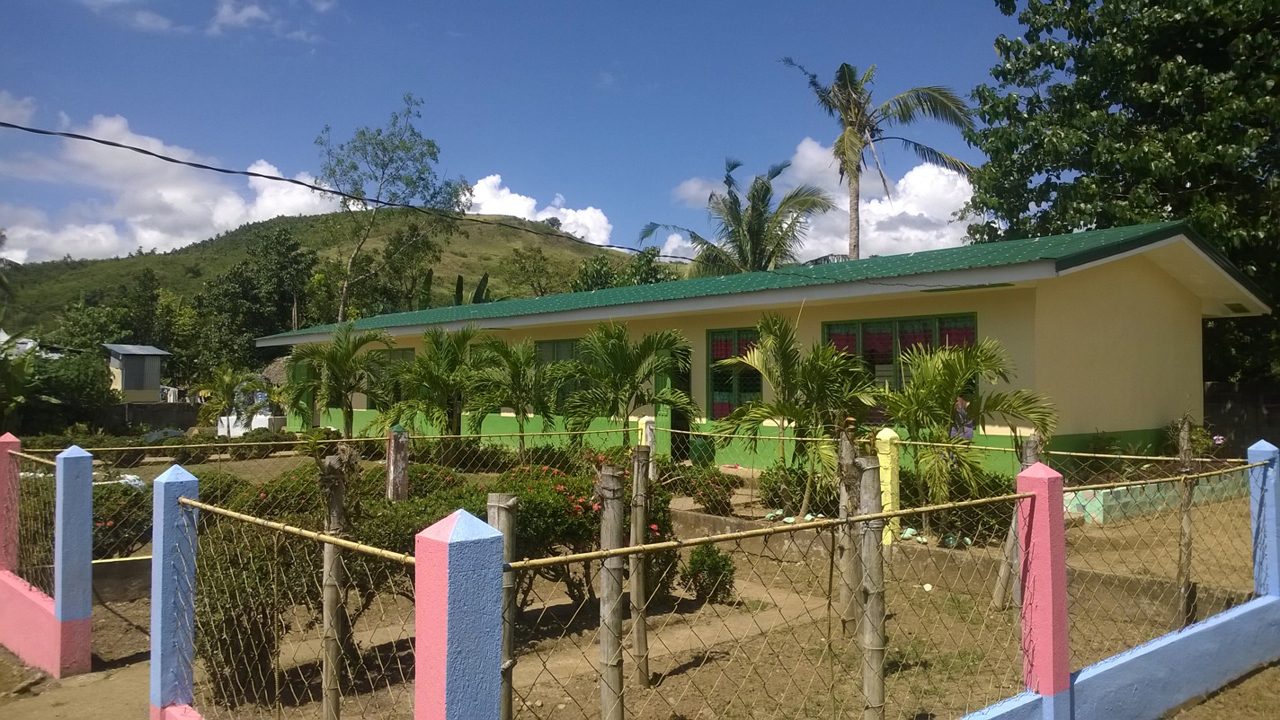SUMMARY
This is AI generated summarization, which may have errors. For context, always refer to the full article.

LEYTE, Philippines – “Ganahan na ko mosulod ug klase kay mas hayahay na man among room.” Richie Iñigo, 7, a Grade II student of a public elementary school in Ormoc City here, is excited going to school now because the rooms are now “comfortable.”
He and the 281 students of Barangay San Juan Elementary School, located about 18 kilometers at the outskirts of Ormoc’s city proper, used to hold classes in tents after Super Typhoon Yolanda (Haiyan) destroyed their classrooms.
During those months, only 3 to 5 students could attend per class because most of them had lost almost everything to the disaster.
“Dili man sad ko kaeskwela sauna kay basa ako mga libro ug wala ko uniform, unya guba pud among classroom,” said Iñigo, donning a bright school uniform and walking around with his blue umbrella with friends during noon break from classes. (After the typhoon, I couldn’t go to school anyway because my books were soaked and I did not have uniform, and our classroom was destroyed)
On Tuesday, March 24, the school inaugurated its two new classrooms and several renovated ones, a computer room, and a multipurpose stage. They were turned over to the school by a group of non-governmental organizations led by Balay Mindanaw, whose international partners helped in funding the construction of the facilities.
Rappler was among the media outfits hosted by Balay Mindanaw to witness the turnover activity in Ormoc City.
Assuntha Charles, country director of Johanniter International Assistance, reminded the teachers and the community to take good care of the facilities. She said the money that built them came from ordinary people – the working class – in Europe.
“These are not money from rich people, but from ordinary people who made sacrifices so that they can share a little amount for the project, like skipping a meal, giving up pensions, vacations,” Charles told Rappler in an interview.
The Johannitter International Assistance secured a grant from the City of Vienna in Austria of about €48,000 (roughly P2.3 million) for the rebuilding classrooms and the improvement of the barangay water system, repair of the barangay hall damaged by the typhoon, and several health related programs for the village.
Right after Super Typhoon Yolanda in November 2013, Johannitter International Assistance also extended medical help to victims of the typhoon in Ormoc.
Barangay San Juan is a rural barangay that is crisscrossed by a river. Families who live here earn a living through crab fishing. Some families also earn from the vast rice paddies that occupy most of the village’s land area. They get water supply from several common wells from springs that are shared by at least 60 families each.
The computer room inaugurated last Tuesday is expected to house the 6 units that the Department of Education will deliver.
The classrooms in the school have a built-in comfort room with lavatory. Balay Mindanaw, which is based in Cagayan de Oro City, tapped male residents in Barangay San Juan for community work, to construct the classrooms and multipurpose stage under a “work-for-pay” scheme.
The donation scheme makes residents help out in the construction and rebuilding of the school facilities instead of just giving them dole-outs.
Balay Mindanaw was among those in the forefront in rebuilding homes in Cagayan de Oro during the flooding brought about by typhoon Sendong. The group was primarily formed to promote peace building in the conflict ridden Mindanao provinces which later on developed into spearheading relief operations during disasters.
Balay Mindanaw also helped rebuild homes in Bohol province after the magnitude 7.2 earthquake, also in 2013.
Mariza Magan, schools superintendent in Ormoc, said that most of the school rebuilding and renovations after Yolanda were realized with the help of the various non-governmental organizations.
“Projects like these really touched us, it was really the NGOs that helped us get back on our feet,” Magan said.
Agnes Mata, Parents Teachers Association vice president, recalled how difficult it was for their children to go to school as their families were still trying to rebuild their own homes destroyed by the typhoon.
She said that it was also difficult for parents to see their children having classes uncomfortably under tents. It worried them that their children might get sick. She remembers how her husband was trying to secure tarpaulins from city hall so they could be used for the makeshift classrooms.
The teachers were all smiling as they welcomed the delegates mostly from Cebu and Cagayan De Oro cities. Most of the residents flocked to school grounds to witness the turnover, while some brought pineapples and crabs for the guests.
The NGO’s next project is to renovate the San Juan barangay hall, whose roofs were blown away by Yolanda. They are also starting the inspection of water wells being used by the families because they are planning to put up a machine which would filter the water to make it safe to drink.
Charlito Manlupig, director of Balay Mindanaw foundation, remembered how his group first learned about the devastation of San Juan during a relief drive in 2013.
He remembered barangay captain Efrenia Cantero, who had to travel through debris-filled roads to ask for help from the city government because the village residents no longer had food supplies. – Rappler.com
*€1 = P48.48
Add a comment
How does this make you feel?
There are no comments yet. Add your comment to start the conversation.